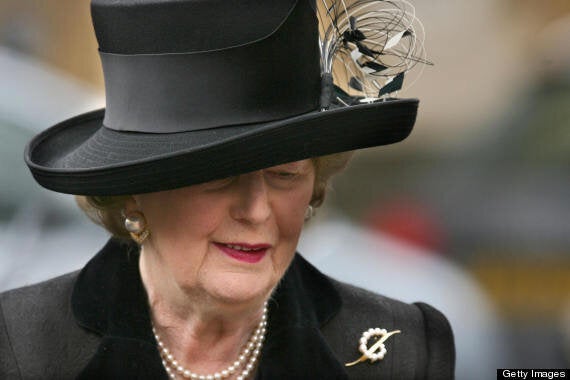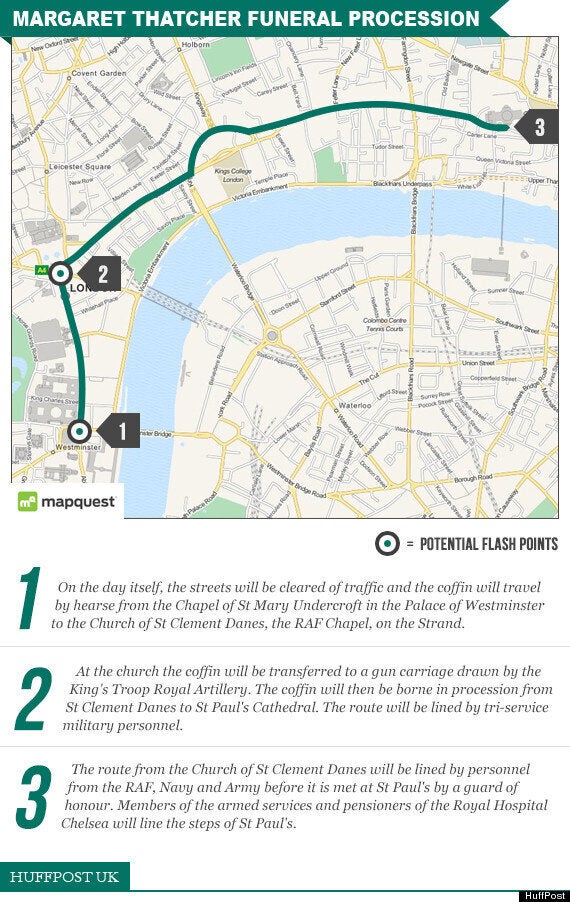Margaret Thatcher's funeral will be the largest the country has seen since that of the Queen Mother's 11 years ago.
The military procession leading to the service at St Paul's Cathedral will feature more than 700 serving Armed Forces personnel from units particularly associated with the Falklands War, including some from the Welsh Guards, the regiment that suffered some of the heaviest losses.

Margaret Thatcher's funeral will be the largest the country has seen since that of the Queen Mother
Major Andrew Chatburn, the man in charge of choreographing the parade, said the plans are based on "precedent and pragmatism" along with the wishes of the former prime minister herself.
"Baroness Thatcher had no direct service relationship. On this occasion it was felt appropriate that service personnel who have an association or connection with the Falklands conflict, for which the late prime minister is pretty famous for, was probably the most suitable on this occasion," he said.
"Of course, Baroness Thatcher's wishes will have been taken into account."
Maj Chatburn, ceremonial staff officer for the Household Division who was also behind the royal wedding procession two years ago and last year's Diamond Jubilee parade, said his department has contingency plans for a number of eventualities but did not have one in the event of the death of the Baroness.
She will have a ceremonial funeral complete with military honours with the procession tailored especially to her, he said.
The last prime minister to have such a send off was Winston Churchill in 1965, but he had a state funeral.
The procession, timed to last 19 minutes, will see the Union flag-draped coffin carried on a horse-drawn gun carriage from St Clement Danes, the church of the Royal Air Force, down the Strand on Wednesday morning.
Led by the Band of the Royal Marines, the solemn procession will then slowly travel along Fleet Street towards St Paul's where around 2,000 mourners are expected to attend the service.
The streets of central London will be lined by men and women from all three services along with three marching bands; the RAF band, which will be closest to St Clement Danes, the Band of the Scots Guards and the Band of the Royal Marines, all with their drums draped in black as a mark of respect.
Once at St Paul's, Lady Thatcher's coffin will be met by a Guard of Honour provided by the Prince of Wales Company of the First Battalion Welsh Guards.
A tri-service bearer party, drawn from ships, squadrons and regiments particularly associated with the Falklands, will then place the coffin on their shoulders and the gun carriage will draw away.
The bearer party, dressed in their regimental or service uniform and who have been carefully selected according to their height, will be made up of the Royal Navy/Marines, Scots Guards, Welsh Guards, Royal Artillery, Royal Engineers, Parachute Regiment, Royal Gurkha Rifles and RAF.
They will then carry the coffin up the west steps of St Paul's which will be lined by 14 pensioners from Royal Hospital Chelsea and 18 service personnel: six from the Navy, six from the RAF and six members of the Blues and Royals, Household Cavalry Mounted Regiment.
The officer in command of the bearing party is Major Nicholas Mott of the Welsh Guards, while the chief marshal, who will walk behind the procession band, is Falklands veteran Colonel Hugh Bodington.
The coffin will be carried on one of six First World War-era gun carriages of the Kings Troop Royal Horse Artillery, used routinely for gun salutes, most recently to mark the 61st anniversary of the Queen's accession to the throne.
The carriage, never used in a funeral before, is likely to be named after Lady Thatcher as is traditional after such occasions. It will be drawn by six black horses, three of them mounted, all with their manes removed to give them a sleeker appearance and stop the harness snagging.
It will be led by a charger named Mister Twister with a second charger to the side of the other six horses, with three soldiers walking alongside the carriage.
Maj Chatburn, previously senior director of music in the household division and director of music in the Irish Guards, said the three bands lining the route will play their martial music slightly subdued in keeping with the solemnity of the occasion, such as that played at the cenotaph on Remembrance Day.
They will stop playing as the coffin is lifted at St Clement Danes.
Meanwhile the procession band will be playing the funeral marches of Chopin, Beethoven and Mendelssohn, with the order expected to be determined during a full rehearsal of the parade in the early hours of Monday morning.
Maj Chatburn said the procession poses a "significant challenge for the musicians" as the pace of funeral marches is irregular. While the pace of the music is 60 beats per minute, the procession will move at 70 beats per minute due to the speed the horses walk.
A total of 183 musicians are taking part.
"The devil is in the detail and if you don't plan, you'll fail," Maj Chatburn said.
"The soldiers, sailors and airmen that we have on parade are all professional soldiers, sailors and airmen first of all. They all come into this specifically for this job, they will concentrate on this for the next two or three days. They are professional service personnel who will address this with the dignity and solemnity and, more importantly, the professional approach that one would expect of the armed services.
"But that doesn't mean to say that we're complacent at all. We will take whatever lessons we learn from this and we will apply them to whatever comes forth."
Maj Chatburn said the "threat" of protesters disrupting the procession is a matter for the police.
But the servicemen and women "will adapt to whatever is required of them, they are serving soldiers, sailors and airmen".
He said: "Many of these have served in Afghanistan and if there is anything that they have to adapt to, they will adapt with it within the confines of their responsibility."
No members of Lady Thatcher's family will be walking alongside the coffin and the parade will not feature any civilians, he said.
During the procession the Honourable Artillery Company will fire Processional Minute Guns from the Tower of London with the first round fired as the wheels of the gun carriage start to roll and the last one as the carriage stops outside St Paul's.

A single, half-muffled bell will toll as the funeral cortege draws up to St Paul's.
Fourteen Chelsea Pensioners will line the steps as the coffin is borne aloft into the cathedral.
In front of the coffin, Michael and Amanda Thatcher, grandchildren of the former prime minister, will carry cushions bearing the insignia of the Order of the Garter and the Order of Merit and lay them on the Dome Altar.
At the foot of the lectern there will be two modest arrangements of white lilies and greenery. Flowers will ring the candle.
Further details of the arrangements for Baroness Thatcher's funeral on Wednesday were released today by Downing Street.
The service will be "framed" by British music, with traditional pieces by great British composers played at the beginning and at the end.
Her love of poetry is reflected in her choice of TS Eliot's Little Gidding, which will be printed on the opening page of the Order of Service and William Wordsworth's Ode: Intimations of Immortality on the final page.
David Cameron and Amanda Thatcher will deliver the readings from the King James Bible - of which she was particularly fond.
It was confirmed that the hymns will be He Who Would Valiant Be, Love Divine, All Loves Excelling, Psalm 84 set to the music of Johannes Brahms, and the patriotic verse I Vow To Thee My Country.
The funeral address will be delivered by the Bishop of London, the Rt Rev Richard Chartres.
The presence of the Chelsea Pensioners - the oldest aged 90 - reflects the strong connection Lady Thatcher built up with the Royal Hospital Chelsea over the last 10 years.
Her family has asked that, if people wish to pay their respects, they consider making a donation to the Royal Hospital Chelsea rather than laying flowers.